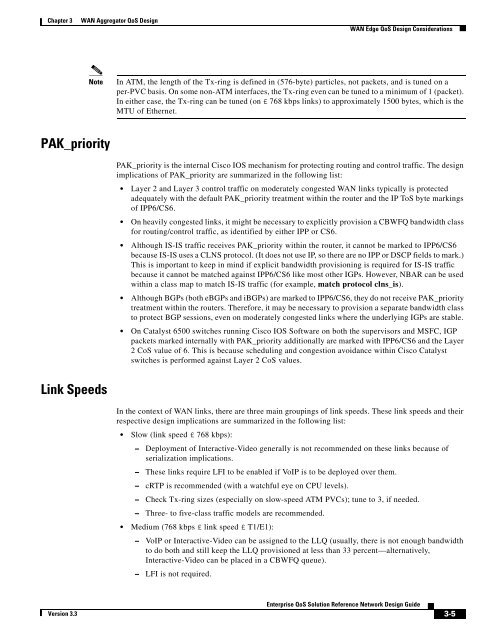Enterprise QoS Solution Reference Network Design Guide
Enterprise QoS Solution Reference Network Design Guide
Enterprise QoS Solution Reference Network Design Guide
You also want an ePaper? Increase the reach of your titles
YUMPU automatically turns print PDFs into web optimized ePapers that Google loves.
Chapter 3 WAN Aggregator <strong>QoS</strong> <strong>Design</strong><br />
PAK_priority<br />
Link Speeds<br />
Version 3.3<br />
WAN Edge <strong>QoS</strong> <strong>Design</strong> Considerations<br />
Note In ATM, the length of the Tx-ring is defined in (576-byte) particles, not packets, and is tuned on a<br />
per-PVC basis. On some non-ATM interfaces, the Tx-ring even can be tuned to a minimum of 1 (packet).<br />
In either case, the Tx-ring can be tuned (on £ 768 kbps links) to approximately 1500 bytes, which is the<br />
MTU of Ethernet.<br />
PAK_priority is the internal Cisco IOS mechanism for protecting routing and control traffic. The design<br />
implications of PAK_priority are summarized in the following list:<br />
Layer 2 and Layer 3 control traffic on moderately congested WAN links typically is protected<br />
adequately with the default PAK_priority treatment within the router and the IP ToS byte markings<br />
of IPP6/CS6.<br />
On heavily congested links, it might be necessary to explicitly provision a CBWFQ bandwidth class<br />
for routing/control traffic, as identified by either IPP or CS6.<br />
Although IS-IS traffic receives PAK_priority within the router, it cannot be marked to IPP6/CS6<br />
because IS-IS uses a CLNS protocol. (It does not use IP, so there are no IPP or DSCP fields to mark.)<br />
This is important to keep in mind if explicit bandwidth provisioning is required for IS-IS traffic<br />
because it cannot be matched against IPP6/CS6 like most other IGPs. However, NBAR can be used<br />
within a class map to match IS-IS traffic (for example, match protocol clns_is).<br />
Although BGPs (both eBGPs and iBGPs) are marked to IPP6/CS6, they do not receive PAK_priority<br />
treatment within the routers. Therefore, it may be necessary to provision a separate bandwidth class<br />
to protect BGP sessions, even on moderately congested links where the underlying IGPs are stable.<br />
On Catalyst 6500 switches running Cisco IOS Software on both the supervisors and MSFC, IGP<br />
packets marked internally with PAK_priority additionally are marked with IPP6/CS6 and the Layer<br />
2 CoS value of 6. This is because scheduling and congestion avoidance within Cisco Catalyst<br />
switches is performed against Layer 2 CoS values.<br />
In the context of WAN links, there are three main groupings of link speeds. These link speeds and their<br />
respective design implications are summarized in the following list:<br />
Slow (link speed £ 768 kbps):<br />
– Deployment of Interactive-Video generally is not recommended on these links because of<br />
serialization implications.<br />
– These links require LFI to be enabled if VoIP is to be deployed over them.<br />
– cRTP is recommended (with a watchful eye on CPU levels).<br />
– Check Tx-ring sizes (especially on slow-speed ATM PVCs); tune to 3, if needed.<br />
– Three- to five-class traffic models are recommended.<br />
Medium (768 kbps £ link speed £ T1/E1):<br />
– VoIP or Interactive-Video can be assigned to the LLQ (usually, there is not enough bandwidth<br />
to do both and still keep the LLQ provisioned at less than 33 percent—alternatively,<br />
Interactive-Video can be placed in a CBWFQ queue).<br />
– LFI is not required.<br />
<strong>Enterprise</strong> <strong>QoS</strong> <strong>Solution</strong> <strong>Reference</strong> <strong>Network</strong> <strong>Design</strong> <strong>Guide</strong><br />
3-5
















